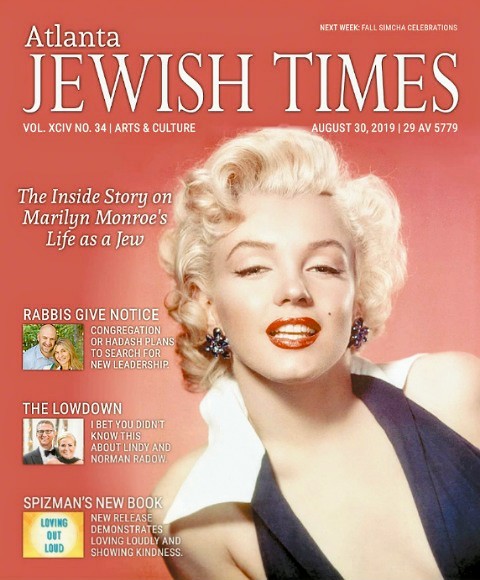
Bob Bahr explores Marilyn’s spiritual side in a cover story for the Atlanta Jewish Times (dated August 30.)
“Monroe once told Paula Strasberg, her drama coach at the time, that she felt a special kinship with her newfound faith. ‘I can identify with the Jews,’ she said. ‘Everybody’s out to get them, no matter what they do, like me.’
On the front door of the home where she died, she had affixed a mezuzah with its tiny parchment scroll of sacred Jewish writings. She still had the prayer book with her personal notes written in its pages, a gift from Miller that had once belonged to the Brooklyn synagogue where he had had his bar mitzvah. On her mantle she kept a bronze menorah, which played ‘Hatikvah,’ the national anthem of the State of Israel. It was a present from Miller’s Yiddish-speaking mother.
Rabbi Robert Goldburg had worked with her during her conversion and provided her with a number of Jewish historical and religious works to study. About three weeks after her death, he wrote of his impressions of her at the time.
‘She was aware of the great character that the Jewish people had produced. … She was impressed by the rationalism of Judaism — its ethical and prophetic ideals and its close family life.’
When she rebelled against the exploitation of the Hollywood studio system, broke her contract with 20th Century Fox and fled Hollywood in 1954 for a new life in New York, it was at the urging of Milton Greene, a popular Jewish photographer with whom she founded Marilyn Monroe Productions. For a while she lived with Greene and his wife and helped take care of their year-old son.
Even before the move she lived and worked in what was largely a Jewish world. In Hollywood her agent and publicist and an early drama coach and mentor were all Jewish. She owed her early success, in part, to personal relationships with the powerful Jewish studio executive Joseph Schenck and the important talent agent Johnny Hyde, who had originally emigrated from the Jewish Ukraine. Her three psychiatrists were Jewish as well as many of her doctors. One of her closest journalistic confidants was the newspaper columnist Sidney Skolsky.But all that accelerated when she moved to New York and enrolled in Lee and Paula Strasberg’s Actors Studio … She quickly fell in with their circle of friends, who made up the theatrical and literary elite of Jewish New York. She volunteered to be the star attraction at a United Jewish Appeal dinner.
The poet Norman Rosten and his wife and children were close friends. She was a regular at a summer of brunches and picnics and cookouts with the Strasbergs in Ocean Beach on Fire Island. She frequently dug into what Paula Strasberg called her ‘Jewish icebox’ there, with its salamis from Zabar’s on New York’s Upper West Side and the honey cakes and fancy European pastries from some of the bakeries started in New York by refugees from Nazi persecution.
It was, in the words of one Monroe biographer, ‘a year of joy,’ made even more joyful by a newfound romance with [Arthur] Miller … Gloria Steinem, the Jewish American essayist and feminist, wrote a perceptive analysis about the relationship and Monroe’s decision just before their marriage to convert to Judaism.
‘Miller himself was not religious, but she wanted to be part of his family’s tradition.”‘I’ll cook noodles like your mother,” she told him on their wedding day. She was optimistic this marriage would work. On the back of a wedding photograph, she wrote “Hope, Hope, Hope.”‘
Her public commitment to Judaism in the mid-50s was just one of the signs that Jews were winning new acceptance in America after the end of World War II and of the changes that the war had brought.
Although she’s been gone these many years, she is not forgotten. Time has treated the memory of Monroe with kindness. Her estate, most of which she left to the Strasberg family, has consistently earned tens of millions of dollars over the more than 50 years since her death … As for that prayer book that Arthur Miller took from his Brooklyn synagogue and Monroe kept to her dying day, it sold at auction last year for $18,000.”
Thanks to Marco at Marilyn Remembered